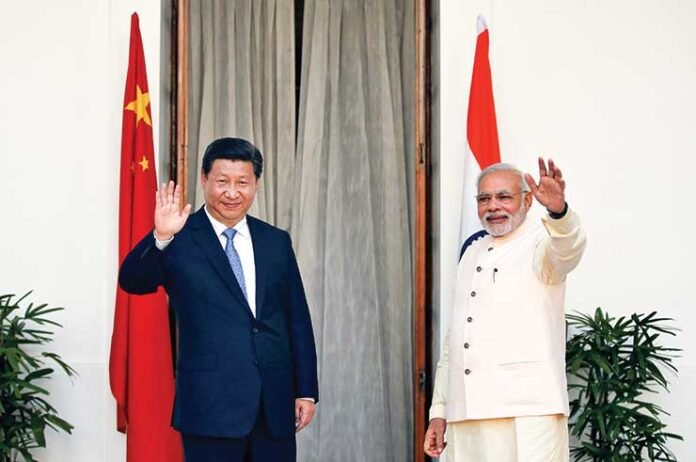The India-China border standoff has continued into 2024, marked by persistent tensions, though there have been some diplomatic efforts to ease the long-standing disputes. The focus remains largely on the Western Sector, where the border issue continues to strain relations between the two nations. However, recent diplomatic talks offer a glimmer of hope for de-escalation and stability. Throughout the year, both India and China have stepped up their diplomatic efforts, including several meetings under the Working Mechanism for Consultation and Coordination (WMCC), on India-China Border Affairs with the 30th and 31st sessions held recently.
This uptick in meetings, the most since the Galwan clashes in 2020, shows an effort from both sides to find some common ground and ease the tensions along the disputed border. Still, a major breakthrough remains elusive. High-level discussions, including talks between defence and foreign ministers and even direct exchanges between national leaders at global summits, have not yet resolved the core issues behind the standoff. Negotiations continue to focus on creating effective disengagement plans and establishing buffer zones to prevent further clashes.
China continues to maintain a strong military presence along the Line of Actual Control (LAC), leveraging its superior infrastructure and military strength to reinforce its position. Part of this posture seems aimed at discouraging India from drawing too close to anti-China coalitions, particularly as broader geopolitical shifts, such as the Dalai Lama succession and the strategic importance of the Indian Ocean region, come into play. The ongoing standoff reflects deeper strategic competition, with both countries vying for influence not only in Asia but globally. India’s engagements with partners like the US, Japan, and Australia in response to China’s moves have added further complexity to its relationship with Beijing.
By late 2024, while the border remains a source of tension, the increased diplomatic talks and a relatively stable military situation—with no major escalations—offer some cautious optimism. Both sides appear to be exploring ways to stabilise the situation, although significant hurdles remain. The international community continues to keep a close watch on developments, hoping for a peaceful resolution that ensures regional stability.
As India and China hold multiple meetings, including the 30th and 31st sessions of the Working Mechanism for Consultation and Coordination, diplomatic efforts are in full swing. However, despite the frequency of these talks, a definitive breakthrough remains elusive as both nations struggle to resolve the standoff along the Line of Actual Control
In July 2024, India’s External Affairs Minister, Dr S Jaishankar, and Chinese Foreign Minister Wang Yi met twice to discuss the prolonged border standoff and broader bilateral issues. The first meeting, during the Shanghai Cooperation Organisation (SCO) Summit in Astana, Kazakhstan, saw Jaishankar stressing the need for disengagement at the border, noting that ongoing tensions hurt both nations. Their second meeting, on July 25 at the ASEAN foreign ministers’ gathering in Vientiane, Laos, showed some progress, with both ministers agreeing on the need for “strong guidance” to complete the disengagement process in Eastern Ladakh.
Jaishankar reiterated that peace along the LAC is essential for normalising relations between India and China, underscoring the importance of mutual respect and sensitivity in managing bilateral ties. However, China’s Ministry of Foreign Affairs adopted a more reserved tone in its statement, emphasising dialogue, communication, and the building of mutual trust while focusing on broader cooperation between the two countries as neighbours and developing nations. Their official readout made a brief mention of the border situation, simply noting a mutual commitment to maintaining peace in the area and continuing border consultations, while placing greater emphasis on shared aspirations for the “Global South.”
At the 30th meeting of the WMCC, held in New Delhi on July 31, 2024, both sides reaffirmed the need to uphold peace and stability in the border regions in line with existing bilateral agreements and protocols. This meeting came just days after Jaishankar, during a speech in Tokyo on July 29 following the Quad Foreign Ministers meeting, strongly rejected any involvement of third parties in resolving the India-China border dispute, insisting that the matter must be resolved bilaterally. He also noted that relations remain strained due to China’s large-scale incursion across the LAC in 2020, which resulted in heightened military tensions at a time when India was grappling with the COVID-19 pandemic.

While diplomatic talks continue, China has pressed ahead with infrastructure developments in the Ladakh sector, including the construction of a heavy-duty bridge in the Pangong Tso area. This bridge is capable of transporting tanks and enables China to quickly mobilise forces on both sides of the critical sector, further raising India’s security concerns. Pangong Tso was a flashpoint for clashes between Indian and Chinese troops in August 2020, and this latest development adds to the sense of unease along the border.
In response to China’s advancements, India is accelerating its own infrastructure projects in the north-eastern regions, particularly in Arunachal Pradesh, a territory China claims as part of its own. India has announced plans to invest USD 1 billion in constructing 12 hydropower stations in the region. This move could further strain relations with China, especially as there are reports that Beijing is considering building dams on the Brahmaputra River, known in China as the Yarlung Tsangpo, which flows from Tibet into Arunachal Pradesh.
On August 29, 2024, India and China convened the 31st WMCC meeting in Beijing, marking the second such meeting within a short period. This followed the guidelines laid out by their foreign ministers during the meetings in Astana and Vientiane in July 2024. Both sides described the exchange of views as “frank, constructive, and forward-looking,” and expressed a commitment to “narrowing down differences” and finding a swift resolution to the ongoing border issues. This appears to reflect a slight softening of previously entrenched positions and suggests that diplomatic and military engagements are intensifying in an attempt to break the deadlock.
With tensions still high along the India-China border, the development of military infrastructure by both sides raises concerns. Yet, ongoing diplomatic exchanges, such as Dr Jaishankar’s discussions with his Chinese counterpart provide hope
On August 31, 2024, at the Economic Times World Leaders Forum, during a session titled “New India’s Risks, Reforms, and Responsibilities,” Jaishankar delved into the unique challenges India faces, particularly in its relationship with China. He noted that, apart from the ongoing border tensions, India also struggles with a growing trade deficit with China, which is driven by China’s long-established economic advantage due to its distinct political and economic system. Jaishankar stressed that understanding the uniqueness of India’s situation is crucial in developing effective policies for managing its ties with China. He also emphasised the need to scrutinise Chinese investments more carefully, explaining that the issue is not whether to allow investments from China, but rather how to determine the appropriate level of scrutiny and oversight.
In response to concerns raised by Indian industries, the Indian government has agreed to expedite the processing of business visas for Chinese technicians involved in manufacturing projects. The Ministry of Home Affairs introduced new guidelines, effective from August 1, 2024, aimed at fast-tracking visa approvals for nationals from China and other countries that share land borders with India. This move is intended to address challenges faced by firms investing in 14 strategic sectors under India’s production-linked incentive (PLI) schemes, which are designed to strengthen the country’s manufacturing capabilities and reduce its reliance on imports.
The India-China border standoff in 2024 highlights the deep complexities of the relationship between the two nations. The broader geopolitical competition between India and China is further complicated by concerns over trade imbalances, infrastructure development, and competing regional alliances. Nonetheless, the continued dialogue and a relatively stable military situation at the border provide some grounds for cautious optimism that a peaceful resolution could eventually be reached.
–The writer is a Special Advisor for South Asia at the Parley Policy Initiative, Republic of Korea. He regularly provides commentary on India-China border issues, water security, and transboundary river challenges in South Asia. You can follow his updates on X at @The_China_Chap. The views expressed are of the writer and do not necessarily reflect the views of Raksha Anirveda










